 |
| RADIOWEALTH APPLIANCE AND ELECTRONIC, FOUNDED IN 1930 |
Since its foundation in 1930,
RADIOWEALTH has been making appliances with an eye to the future, putting out modern products which become
pace-setters in the local appliance market.
It was started by a visionary from Camarines, Domingo M. Guevara (b.1909/d.ca.1990s) who took up a correspondence course to become a radio
technician—even as he was manning the family farm.
After a land dispute that
made him decide to move to Manila, Guevara set up a a one-man radio repair shop
that would grow to become the country’s most dominant, well-known name in
electronics and appliances before Japan-made products took over the market.
The
enterprise, fittingly called RADIOWEALTH, would make Guevara one of the richest
and most successful modern-day industrialists of his time.
 |
| RADIOWEALTH VINTAGE LOGO, 1955 |
The company’s history has interesting highlights:
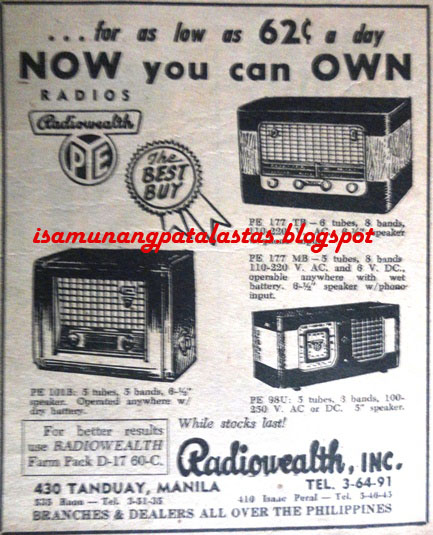 |
| OWN A RADIO FOR 62 CENTAVOS A DAY, 1957 |
1930 - Founded by Domingo M. Guevara as a radio repair
shop an later, as a radio dealer.
 |
| RADIOWEALTH-THE BEST BUY! 1957 |
1935 – Incorporated, started importation and distribution
of radio sets.
 |
| RADIOWEALTH HAS THEM ALL!, 1957 |
1951 – Under exchange controls, launched assembly of
radio sets.
 |
| FOREFRONT OF ELECTRONIC PROGRESS, 1955 |
1955 – Pioneered in the manufacture of TV sets.
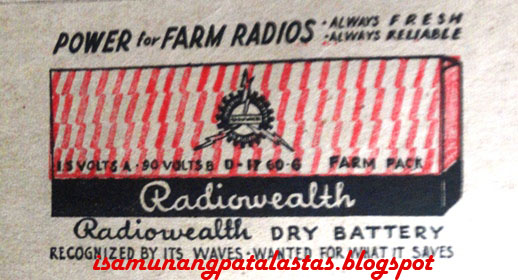 |
| RADIOWEALTH DRY BATTERY, 1957 |
1956 – Started the manufacture of electronic components
such as transformers, coils, chassis and metal parts.
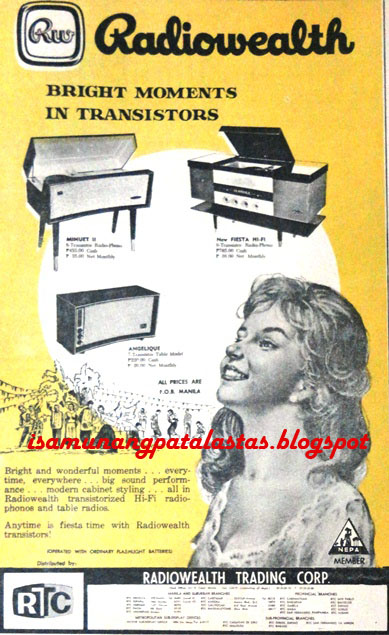 |
| BRIGHT MOMENTS IN TRANSISTORS, 1955 |
1958 – Started the manufacture of room air conditioner.
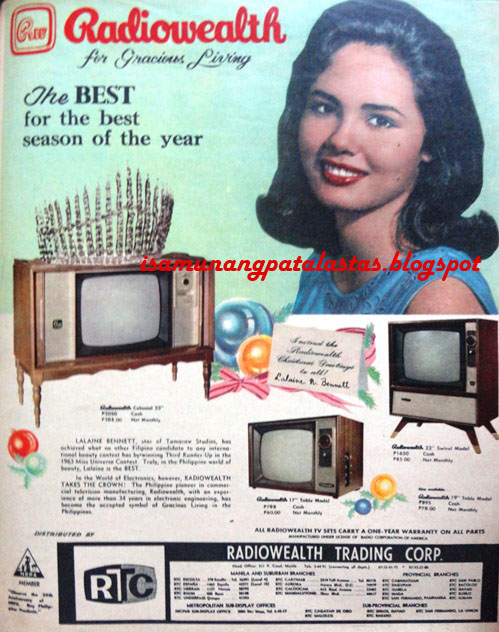 |
| MISS PHILIPPINES LALAINE BENNETT MODELS FOR RADIOWEALTH, 1963 |
1963 – Started the manufacture of local televison tuners
under a license from Standard Kollsman Industries, the major manufacturer of TV
tuners in the U.S.
 |
| RADIOWEALTH CARMEN MODEL, COMBINATION TV, PHONO, STEREO. 1965 |
1964 – Introduced TV sets with the implosion-proof
Shellbond picture tube.
 |
| RADIOWEALTH ODOR-FREE KOLDPOINT, 1972 |
1965 – Introduced Koldpoint refrigerators
 |
| NOCTURNE PANORAMIC HI-FI RADIO-PHONO, 1960 |
1966 – Organized nationwide Radiowealth franchise
dealerships.
 |
| RANGE OF RADIOWEALTH BRANDED PRODUCTS, 1968 |
1967 – Introduced the RW-RCA TV. Added ranges, beds,
pianos, to its household appliance lines. Received Presidential Award for
pioneering in electronics.
1968 – Acquired production facilities for manufacturing
Worthington central and packaged air conditioning systems.
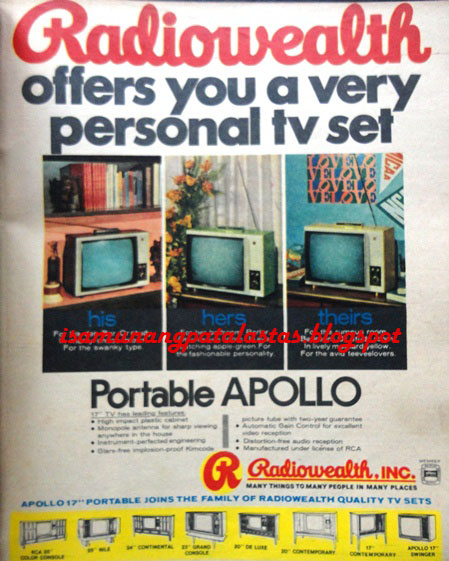 |
| RADIOWEALTH PORTABLE APOLLO, 1972 |
1969 – Introduced the revolutionary Apollo 19 TV with
Bubble Screen, the Nocturne LSD stereo with Light and Sound Diascope and the Interlude AC-DC operated
stereo.
This year, RADIOWEALTH developed the Professional modular
super solid state component stereo, the Apollo 16 and the Apollo 17 TV.
 |
| 1ST AC-BATTERY CONSOLE STEREO, 1969 |
The company also designed and invented an authentic
voltage regulator which saves appliances from damage resulting from voltage
irregularities. The inexpensive device is now on the market.
 |
| NOCTURNE LSD WITH PSYCHEDELIC LIGHTS, 1969 |
RADIOWEALTH subscribed to professional advertising and
the brand was actively promoted tri-media and in-store. The brand continued to
flourish through the 70s, but the influx
of Japanese brands caused major shifts in brand preference. RADIOWEALTH, thus,
embarked on a “Buy Filipino” Campaign.
 |
| RADIOWEALTH XMAS AD, 1969 |
But by then, Guevara was secure in his RADIOWEALTH business
and had branched out to other other lucrative pursuits. He even forayed into politics –elected a
delegate to the 1971 Constitutional Convention that he thought he could
use to advance his platform of
industrializing the Philippines.
 |
| AFFORDABLE RADIOWEALTH COLOR TV, 1969 |
When Martial Law was declared, Guevara’s business plan
was jeopardized, especially since he was one of 7 delegates who voted against
martial law. Because of this, he was pressured by the Marcos government which
wanted to take over his successful business. Knowing it was futile to fight
Marcos, Guevara—whose health has been affected by the turn of events—together with
his wife, fled to the United States.
 |
| RADIOWEALTH, YOURS FOR YEARS. 1971 PRINT AD. |
RADIOWEALTH eventually closed, signaling an end of a shining era
of industrial revolution. But Guevara’s legacy remains in Mandaluyong, where a busy,
bustling street on where his manufacturing plants stood-Libertad St.--has been renamed after
him—Domingo M. Guevara St. the self-made industrialist died in the 1990s.
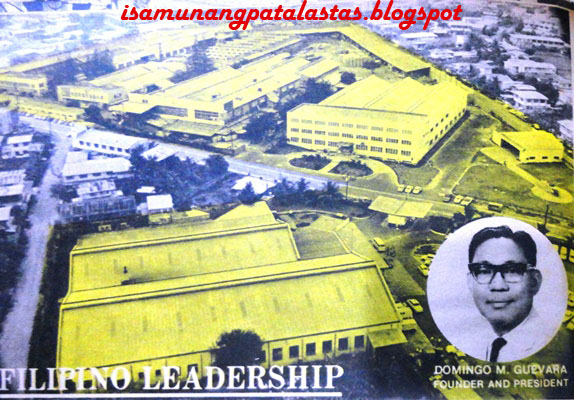 |
| THE GUEVARA ENTERPRISE MANDALUYONG PLANT in 1970 |
SOURCES:
Various issues of the Sunday Times Magazine, 1963-1972
Various issues of Philippine Free Press, 1955-1960







































